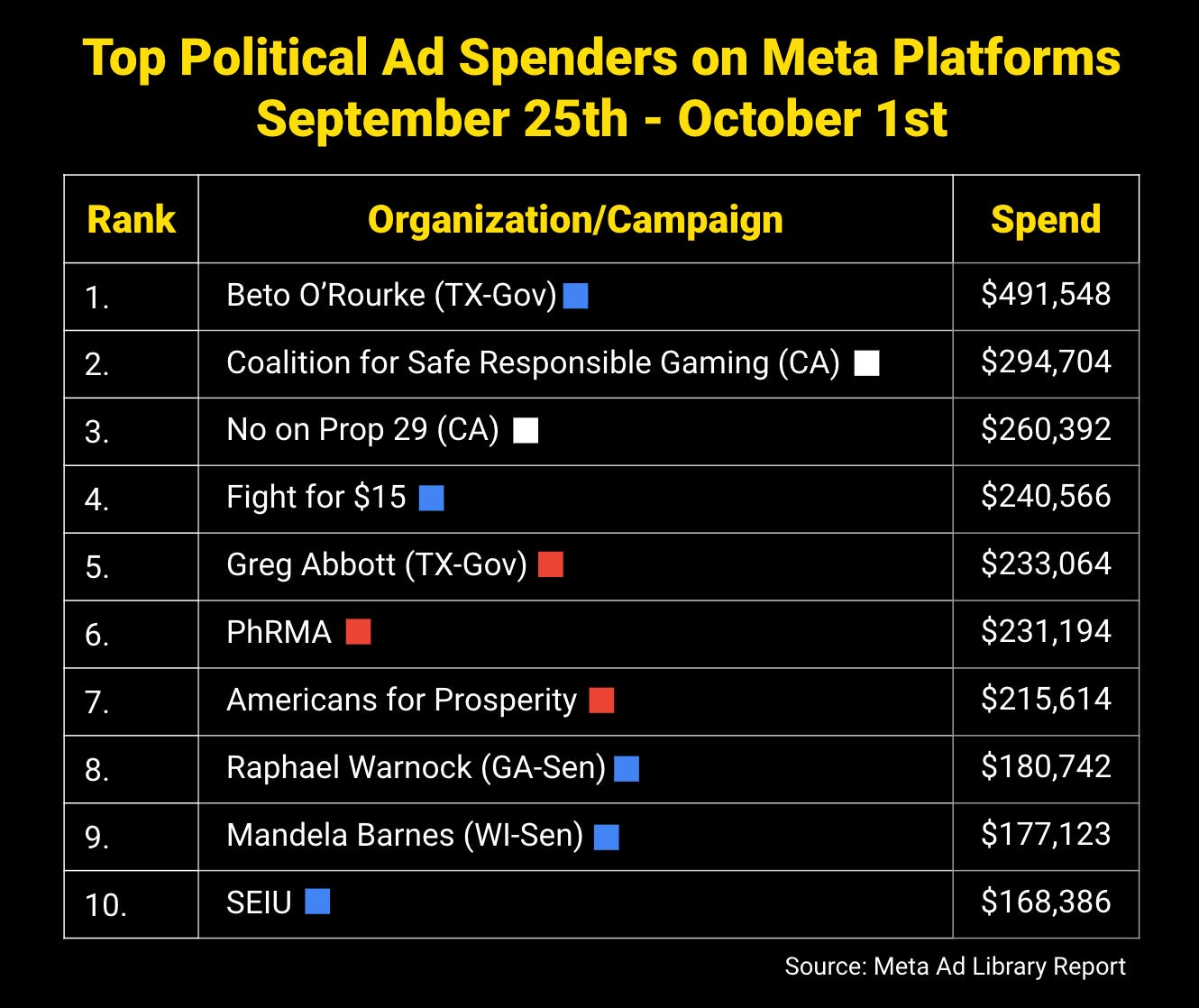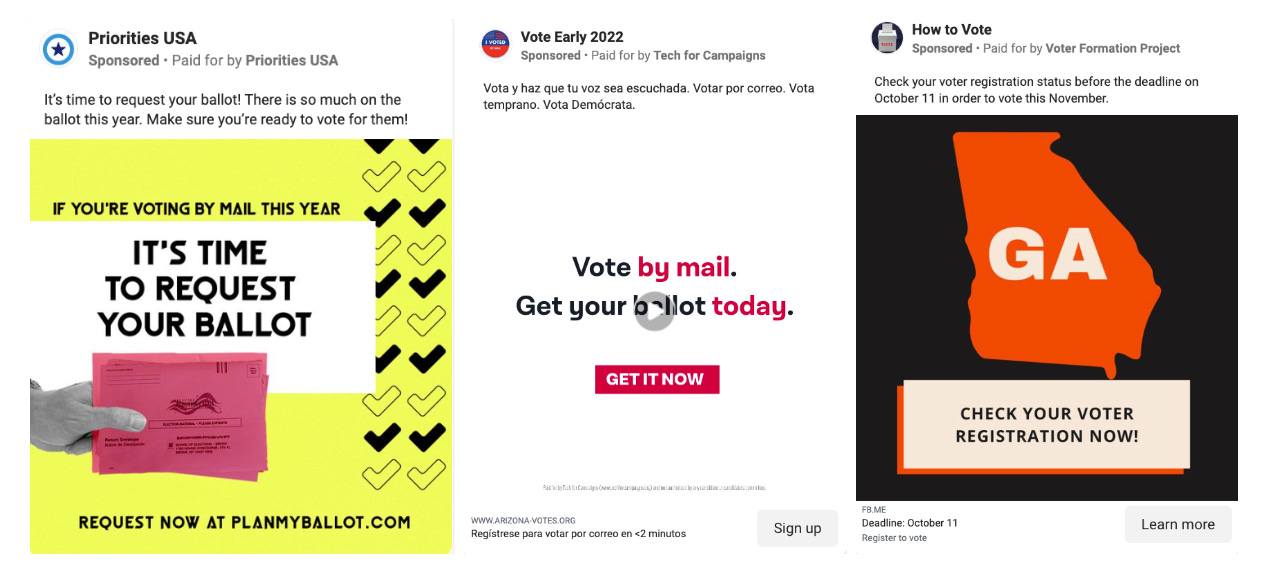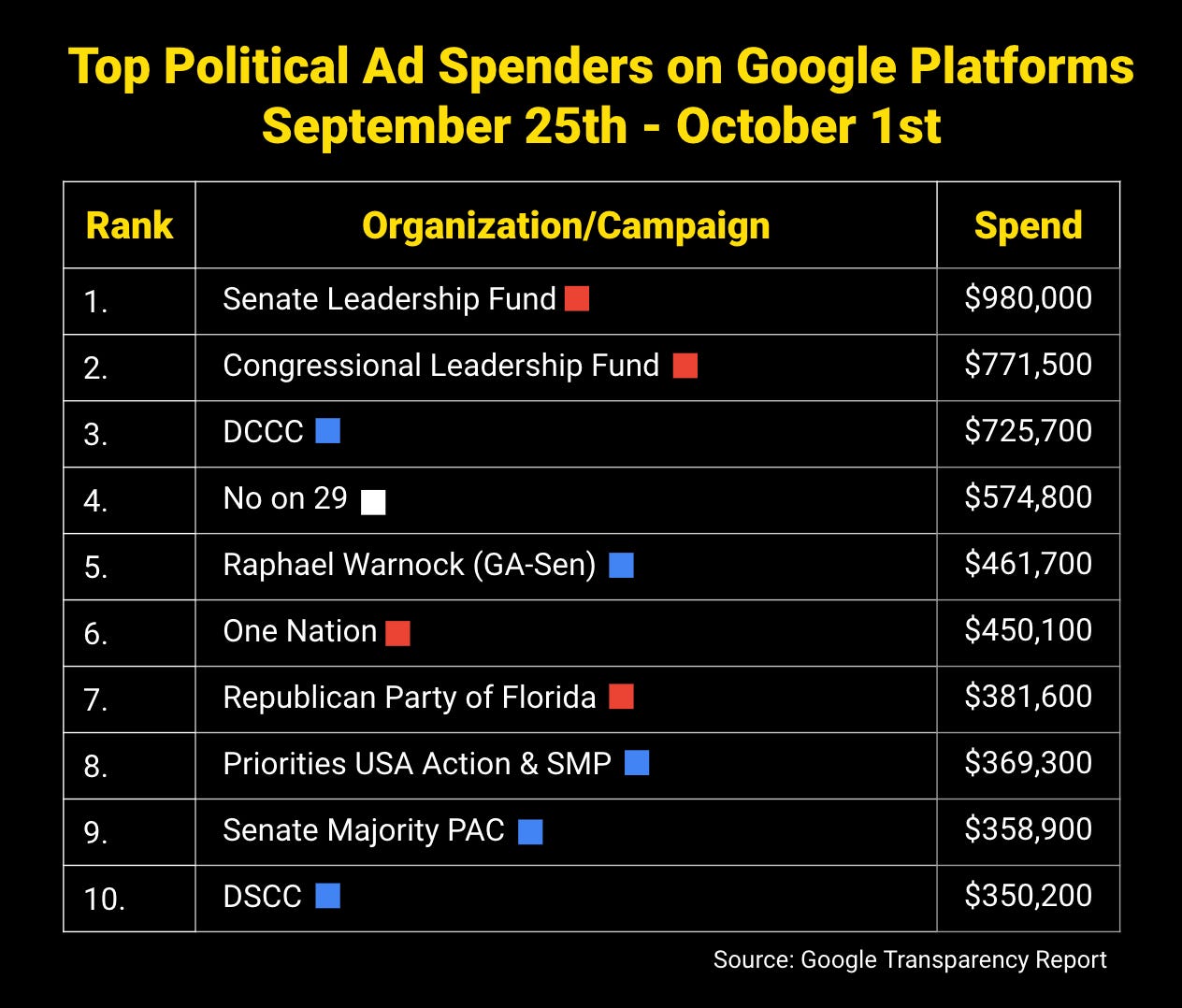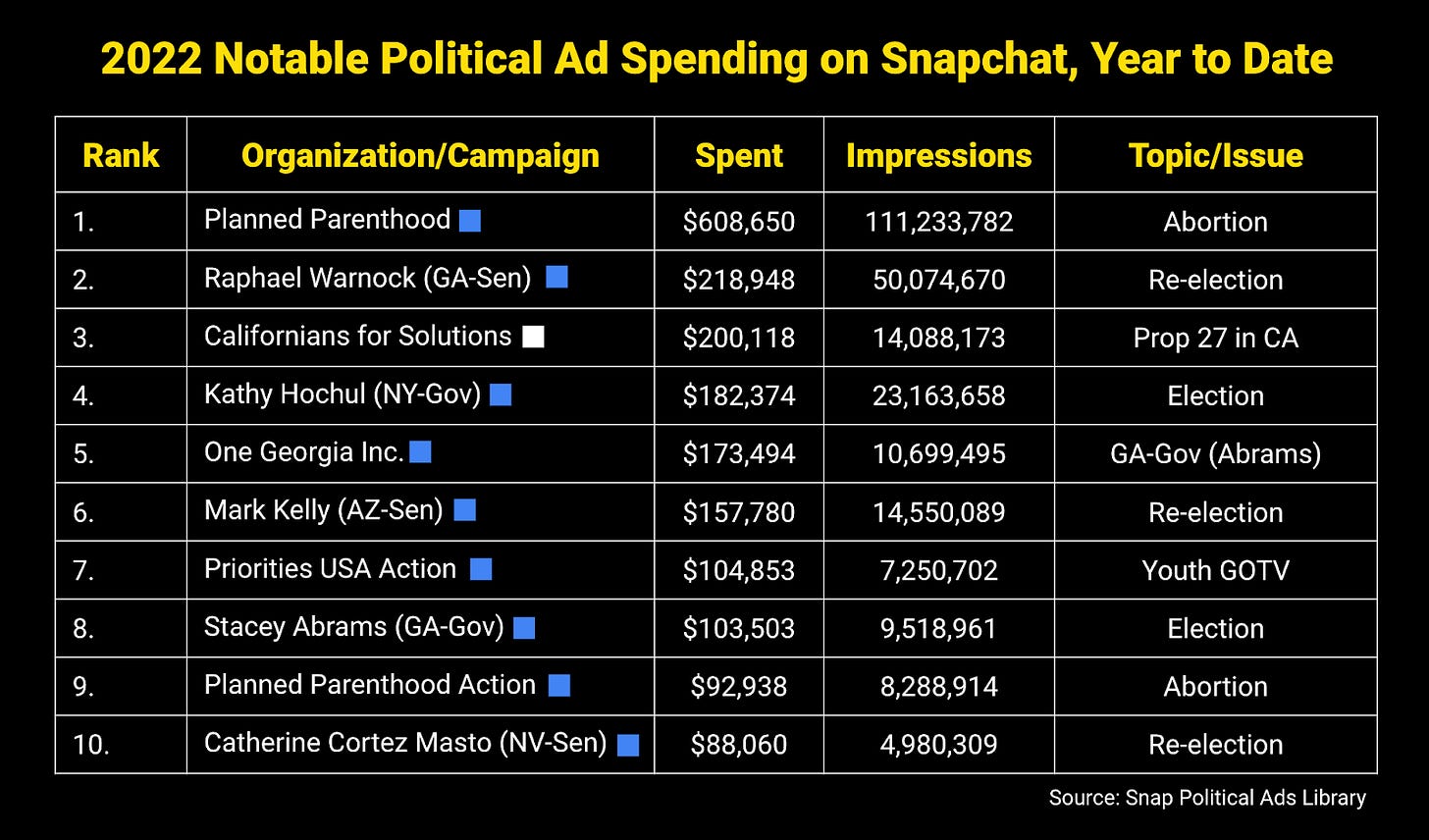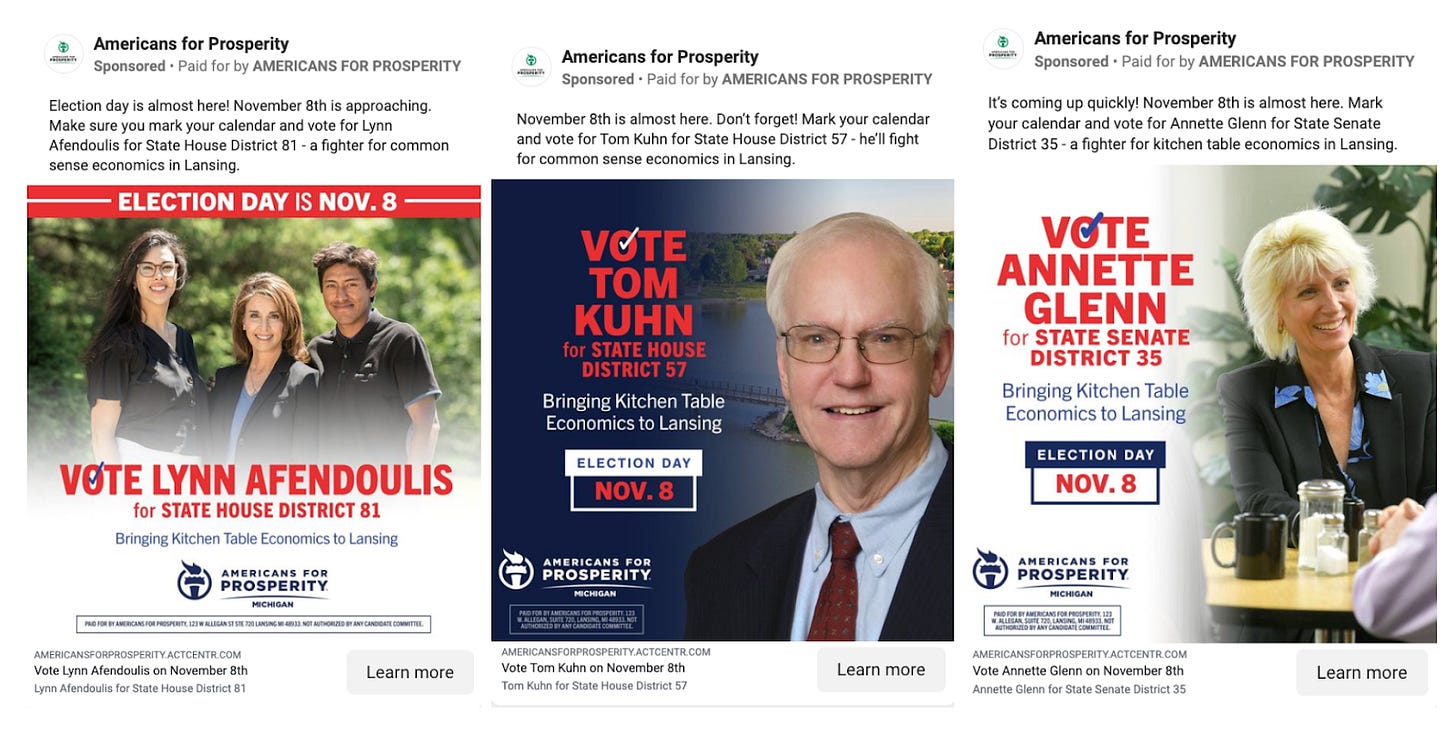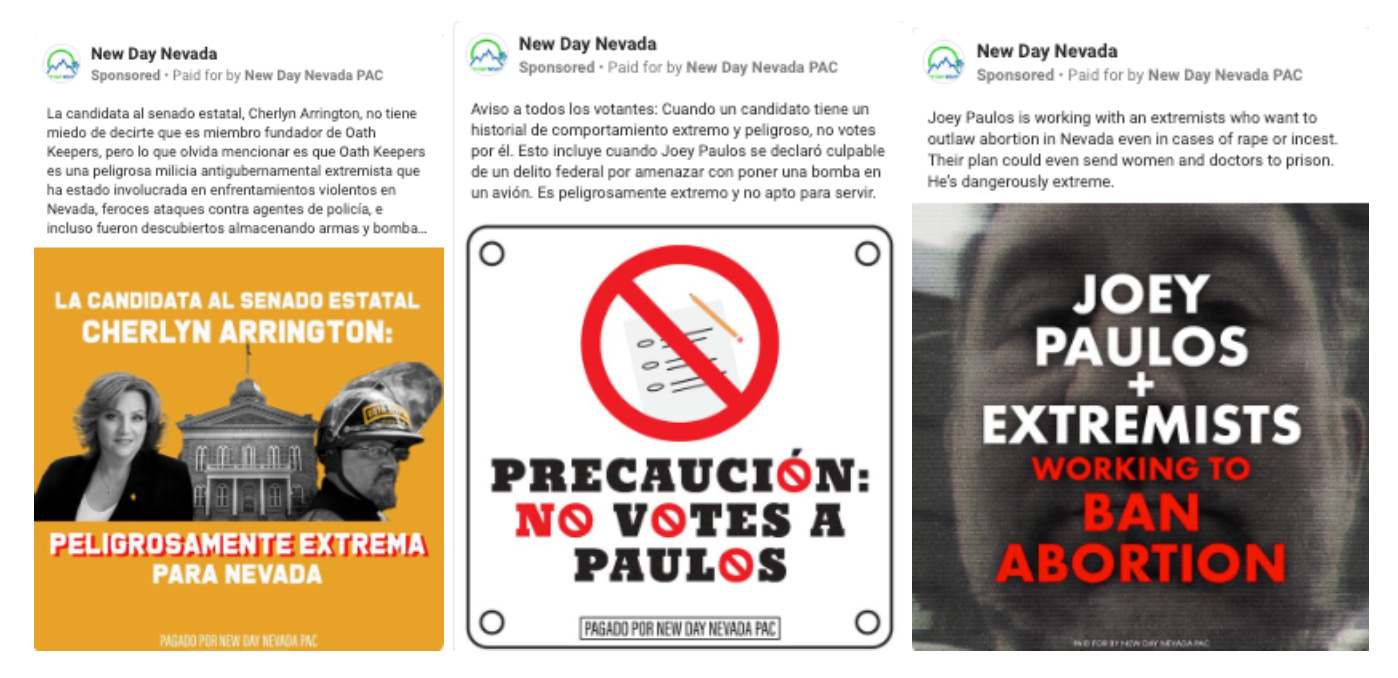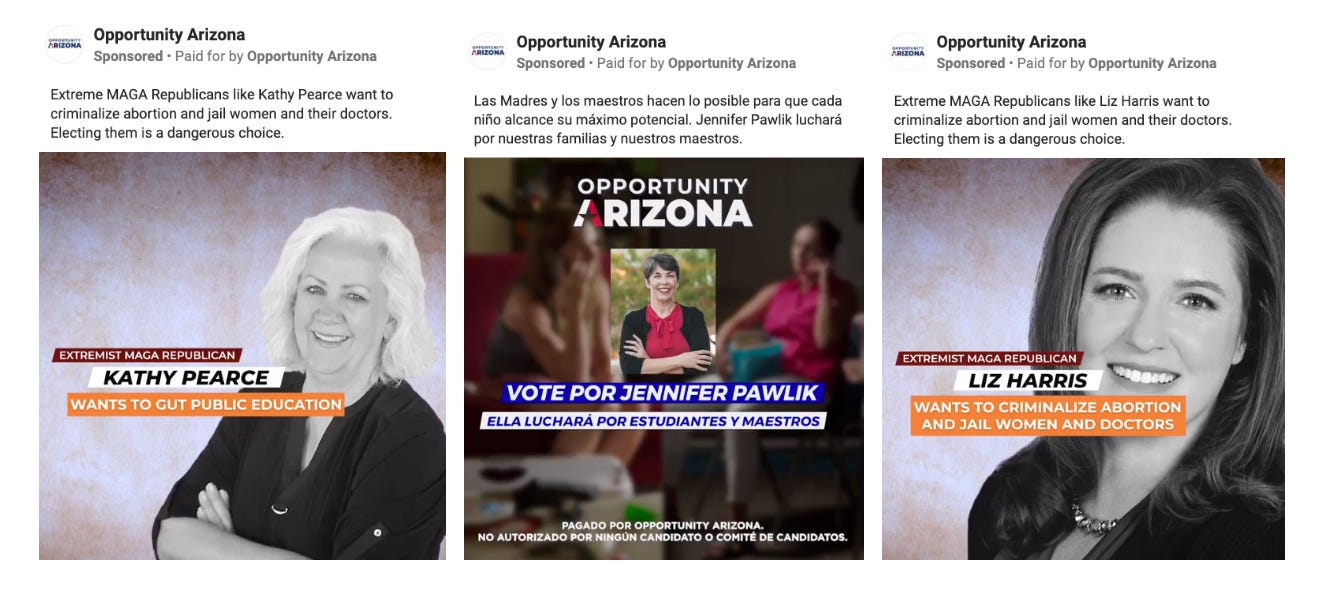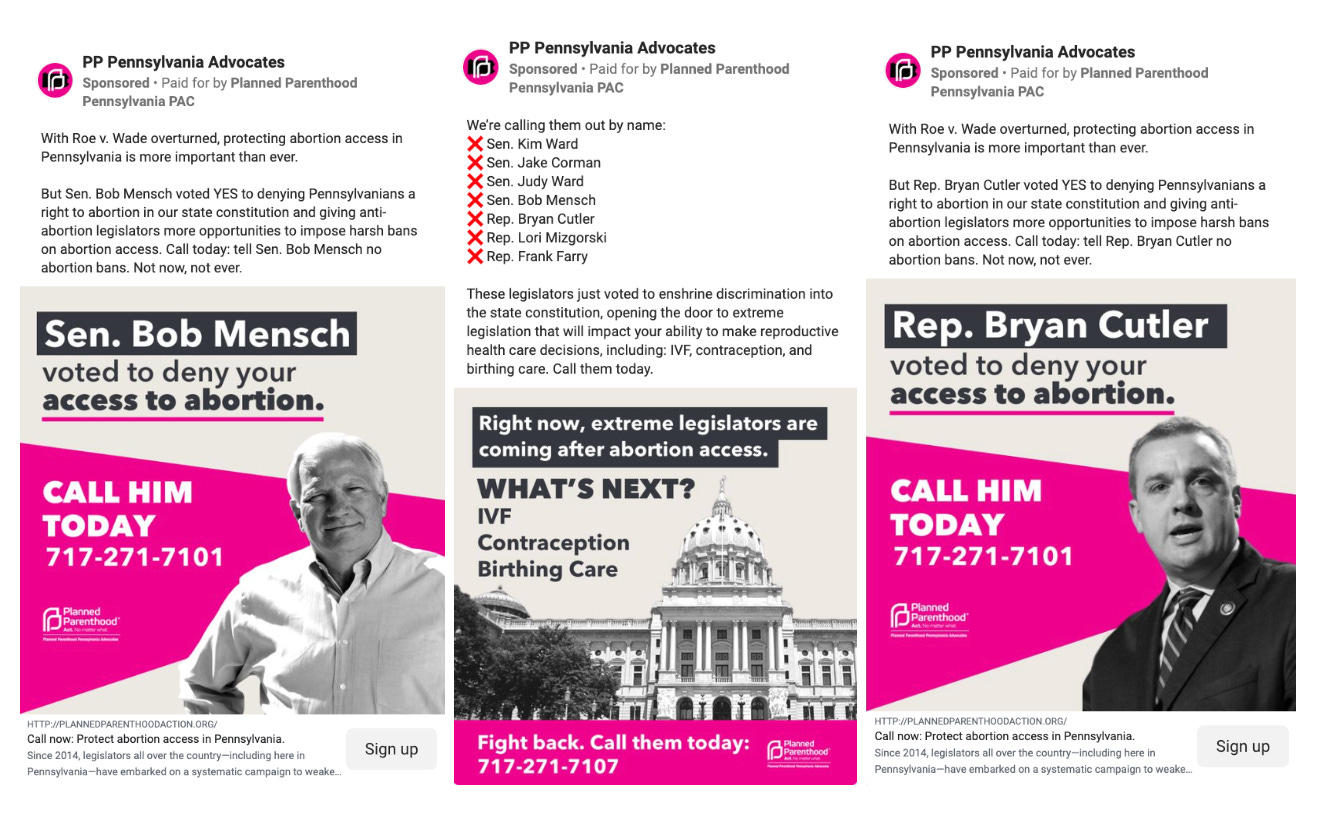The digital dogfight for key statehouses
Control of state legislatures will have an outsized impact on the future of our democracy. Here’s how key battles are playing out online.
This week’s issue is being published in partnership with This Week in Statehouse Action, a newsletter about state legislative politics from Carolyn Fiddler & Courier Newsroom.
What happens in state legislatures has an outsized impact on literally every aspect of our lives. This November, *thousands* of state legislative seats are on the ballot - and in this week’s FWIW, we’re taking a detour away from national politics to highlight the digital state of play in four states where state legislative majorities hang in the balance.
But first…
By the numbers
FWIW, here were the top-spending political advertisers on Facebook + Instagram last week:
We’ve now reached the stage in the election when a number of partisan and nonpartisan groups begin large-scale attempts to make sure voters are ready for early voting, casting or requesting mail-in ballots, or Election Day itself. On Facebook, that means hundreds, if not thousands of ads from groups like Priorities USA, Tech for Campaigns, Voter Formation Project.
Meanwhile, here were the top political advertisers on Google platforms last week, including YouTube:
Google and Youtube spending was *way up* last week, as Election Day quickly approaches. Several major Democratic advertisers - the DCCC, DSCC, Senate Majority PAC, and Priorities USA have now begun to catch up to major conservative groups in spending on these platforms.
…and here are the top political ad spenders on Snapchat so far this year:
For premium subscribers, we provide detailed historical digital spending data in U.S. Senate, House, and Gubernatorial races.
From around the internet
High-profile campaigns released their quarterly fundraising numbers this week. Here are a few we were watching for: Warnock: $26m/Walker: $12m, Fetterman: $22m/Oz: $17m, Barnes:$20m/Johnson: ???
Speaking of fundraising, Tim Miller has an excellent take in the New York Times bemoaning the sad state of grassroots fundraising in politics.
Now that we’re in the heat of general election season, plenty of Republicans have softened their rhetoric and policy positions since winning their primaries. The clearest example of that this week came from one candidate running for Congress in Colorado. We kept the receipts though. >>
Which midterm candidates are receiving the most reactions, comments, and shares on their campaign’s Facebook posts? Click here for a weekly round-up>>
Inside the digital dogfight for key statehouses
As a regular reader of this newsletter, you’re likely already aware that state legislatures have an outsized impact on literally every aspect of our lives – which is why the thousands of state legislative seats on the ballot on Nov. 8 are incredibly important. But real power in legislative chambers is determined by majority control, and thanks to incredible (mostly pro-GOP) gerrymandering and the quirks of our representative system, only a handful of states have contests that could drastically shift the balance of that power.
Michigan, Nevada, Arizona, and Pennsylvania are among the top states where majority party control could flip this year. Democrats are playing offense in all but one: Nevada. And yet, even with meaningful opportunities to win real power in these crucial states with issues like reproductive freedom, education, and democracy itself on the line, these crucial races are (...remain) chronically underfunded by the left.
Advertising in state legislative races is especially important because candidates often suffer from low name-ID, and many voters are unfamiliar with who’s running for what. Despite underinvestment in these types of races in years past, spending on state legislative elections this year has already exceeded $130 million, including TV and digital ad spending, with Republicans having spent significantly more than Democrats.

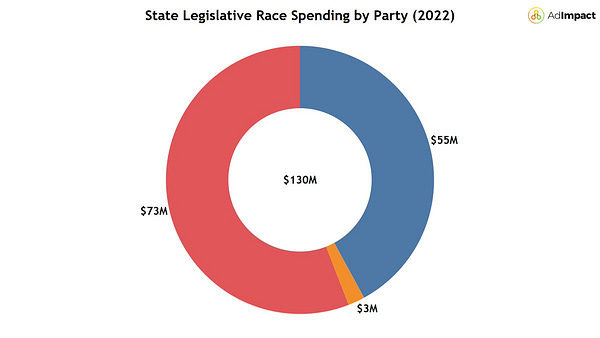
Just looking at digital ads, however, Democrats are faring a little better. To provide a decent baseline for comparison, 2021’s off-year election in Virginia saw a little over $1 million in Facebook and Google ad spending for legislative races. In at least one key state this cycle, digital paid media investment has already blown past those numbers.
Let’s dig in:
Michigan
For the first time in over a decade, Democrats have a fair shot at flipping one or both chambers of the GOP-controlled Michigan legislature, thanks entirely to a successful citizen-initiated ballot measure in 2018 that created an independent redistricting commission. Democrats need to flip just two House seats (of 110) to take control of that chamber, and flipping four state Senate seats (of 38) would give Dems a majority there.
In addition to being one of the rare states without GOP-gerrymandered maps, the political landscape in Michigan is colored by an intense statewide focus on another ballot measure: Proposal 3, which would enshrine reproductive freedom in the state constitution. These factors, in addition to three Democratic incumbents running for reelection statewide at the top of the ballot, have created a unique opportunity for team blue this year.
Out of all the states that have competitive state legislative elections this year, Democrats and their allies seem to be running their most sophisticated digital operation here. Candidates, the state party, and outside groups alike are hammering Republicans across the state with abortion-related advertising.
Over the past 90 days, the top spender on political Facebook ads in Michigan was not Gov. Gretchen Whitmer’s campaign or some large national advocacy group - it was a relatively obscure progressive digital political outfit called the Main Street Sentinel. The liberal site, somehow affiliated with a progressive Facebook network called Real Voices Media, has spent over $700,000 on ads supporting Democrats running for the state legislature and other offices.
The state party has spent a huge amount of money on these types of ads as well. In the past 90 days, the Michigan Democratic State Central Committee has spent over $425,000 via a “Michigan Families First” Facebook page, and another $95,000 on YouTube to attack down-ballot Republicans and boost its state legislative slate.
In addition to those two top advertisers, Prosperity Michigan & Prosperity Michigan Action Fund has spent over $200,000 on recent Facebook ads boosting state legislative Democrats in addition to supporting Whitmer, and Forward Majority Action Michigan has also launched new Facebook ad campaigns attacking Republican down-ballot candidates.
Conservatives in Michigan haven’t allowed these ads to go completely unanswered. The Koch-brothers backed Americans for Prosperity and Americans for Prosperity Action Fund seem to be the largest spenders on down-ballot digital ads in the state, promoting their own endorsed candidates to voters in pretty generic ads:
Nevada
Democrats have majority control of both the Nevada Assembly and state Senate, but Republicans are working hard to flip at least one of these chambers. The Silver State is one of the few in which Democrats have trifecta (governorship + both legislative chambers) control of state government, and the GOP is gunning to take that away.
The Nevada Senate is especially vulnerable, since Republicans only need to flip two of the 11 seats on the ballot this fall (terms here are staggered–the other 10 members are up in 2024).
The battle for chamber control is a tougher one for the GOP in the Assembly, as they’ll need to flip five of those 42 seats to flip it.
Nevada is another state that is seeing medium to large-scale digital ad investments from progressive outside groups in state legislative contests. The top spending advertiser in this regard is a group called New Day Nevada, which has spent more than $350,000 on Facebook ads over the past 90 days. That organization is hammering Republican candidates with attack ads in English and Spanish related to abortion and extremism.
Nevada Legislative Victory has also spent around $40,000 running Facebook ads attacking Republicans for wanting to ban abortion, as has the American Leadership Committee - Nevada, running $20,000 of very similar anti-Republican, pro-abortion rights ads on Facebook.
Together, those three liberal advertisers make up the bulk of digital ad spending in Nevada’s state legislative elections, and Republicans are largely MIA.
Arizona
Statewide races in Arizona are taking up most of the oxygen here, but given how narrow the GOP’s grip is on the legislative majority in both chambers, this could be an opportunity for Democrats. Team Blue needs to flip just two seats (of 60) in the state House to take majority control there, and flipping just one seat in the state Senate would break the Republican majority and tie the chamber 15-15.
In Arizona, we’ve seen much less digital spending related to state legislative elections (and much more spending on the major statewide contests). From what we can tell, a few advertisers have spent just a few thousand dollars on Facebook ads supporting a handful of candidates, but that’s mostly it. Democrats are generally outspending Republicans online.
One progressive organization, Opportunity Arizona, appears to be the largest advertiser on Facebook in these races - spending a little over $30,000 in the past few months attacking Republican candidates for their abortion positions and extremist MAGA ties as well as supporting Democrats on the ballot.
At the same time, a few individual candidates like Laura Terech and Christine Porter Marsh have run small but mighty Facebook ad campaigns introducing themselves to voters and running contrast ads on issues (like abortion rights).
Pennsylvania
The Keystone State presents another opportunity where Democrats have non-GOP gerrymandered legislative maps for the first time in over 10 years, though the road to the majority in either chamber is tougher here (many experts expect it to be a two-cycle endeavor). Democrats need to flip 12 seats (of 203) in the House to win majority control of that chamber. Like Nevada, the Pennsylvania Senate has staggered terms, and half of the upper chamber’s 50 seats are on the ballot in November; Democrats need to flip four of them to win a majority.
Pennsylvania has also seen limited investment in digital ads supporting or opposing state legislative candidates - the exception comes from a few progressive outside groups. First, Planned Parenthood’s Pennsylvania affiliate is blanketing the state on Facebook attacking Republican legislators on yep, you guessed it - abortion rights. The group has spent over $52,000 on these ads in the past 90 days, as well a few thousand bucks on YouTube:
Similarly, progressive nonprofit Red, Wine, & Blue has spent over $30,000 during the same time period attacking Republican legislators on the issue. The pro-environment Conservation Voters of Pennsylvania has also run advertising in these races - spending around $27,000 on recent ads promoting a state legislative environmental policy “scorecard.”
TL;DR
Phew, that was a lot.
As you can see above, Democrats - especially outside nonprofits and affiliated PACs - are far outspending Republicans in key state legislative fights online. However, as Ad Impact notes, that digital spending advantage is leveled by heavy Republican spending elsewhere.
When it comes to how campaigns are messaging in these races, it’s all abortion rights, all day. From Michigan to Arizona, Democrats are hoping that branding local Republican candidates as too extreme on the issue will help them coast to victory - and reclaim majorities in several key chambers.
Can’t get enough of the state legislative content? Subscribe to Carolyn’s newsletter, This Week in Statehouse Action here>>




